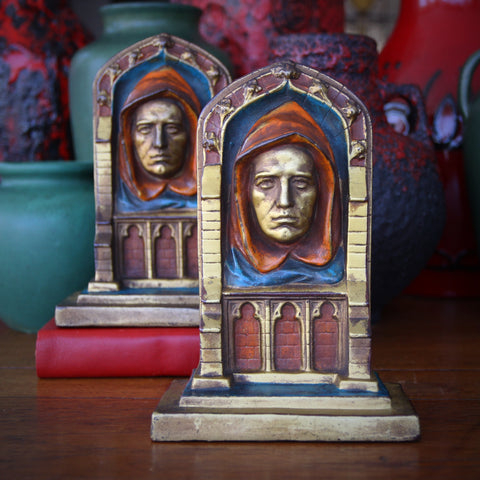Hooded monks stare-out from these polychromed, bronze-clad Gothic Revival bookends made by J. B. Hirsch in the 1910's or 1920's. The company was founded in 1907, on the Lower East Side of Manhattan, by Joseph Hirsch, a Rumanian immigrant. He hired designers to sculpt the original models for bookends, like the pair above.
To make bronze-clad bookends, first a model was sculpted. From the original model, moulds would be made in which plaster "composite" duplicates were cast. These plaster sculptures were then electroplated: hung in a vat of water mixed with bronze powder and zapped with an electrical current, during which the bronze powder formed a solid bronze "skin" around the plaster form. Once the bronze skin was attached, the object could be patinated or painted as bronze would be.
The American Arts & Crafts period—like Arts & Crafts periods elsewhere—sought to "revive" artful elements of ancient mythology, literature, symbolism or the aesthetic culture of its country. The Gothic period of Europe proved a rich source of creative inspiration (as these bookends will attest).
After World War Two, Joseph Hirsch's company took an interesting turn. Pre-War France had a legacy of having made spelter (zinc) castings—used for bookends, lamps, ashtrays and other small decorative objects. These finely-cast items were sometimes called "French Bronzes." With Germany invading, one of these French Bronze foundries decided to bury their moulds under the factory floor—carefully separating the different parts of each mould and scrambling them. They didn't want anyone else, especially the invaders, to find and use their moulds. By the time the War was over, aesthetic styles had changed and the foundry decided to leave the moulds underground. Hirsch heard stories of these moulds and decided to find the foundry owner and buy his old moulds. The digging was ambitious and reassembly was difficult, given the separation and mixing of all the parts. But Hirsch brought the moulds back to America and began to cast the French Bronzes to much success. By the Post-War period, Hirsch's original product line (bronze-clad items) had pretty much run its course. The specter French Bronzes provided a new chapter for the company.
At over 8 inches tall and six inches wide, these bookends provide a bit of visual (and actual) heft—holding-up your cherished tomes. Click on the photo above to learn more about them.
Though our Greenwich Village store is now permanently closed, LEO Design is still alive and well! Please visit our on-line store where we continue to sell Handsome Gifts (www.LEOdesignNYC.com).
We also can be found in Canonsburg, Pennsylvania, at The Antique Center of Strabane (www.antiquecenterofstrabane.com).
Or call to arrange to visit our Pittsburgh showroom (by private appointment only). 917-446-4248


